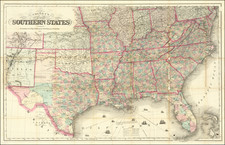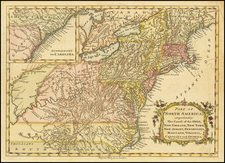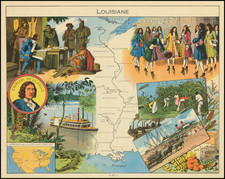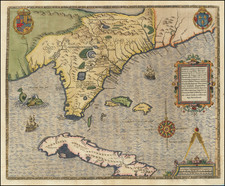Fine separately issued map of Belmont, the first Territorial Capital of Wisconsin Territory, published in New York by Miler & Co. for Van Antwerp & Van Dyke, in anticipation of a land auction to be conducted in New York City on October 3, 1836.
The map provides that it is a true copy of the original manuscript map presented by John Atchison, "proprietor of the within Town of Belmont. . . " to the Justice of the Peace in and for the County of Iowa, Territory of Michigan and originally sealed on May 15, 1836. In all probability, the present map was printed prior to the formal organization of Wisconsin Territory, in order to facilitate the sale date listed in the title.
The map, which lays out the early town and sets aside land for both the Territorial Capital and County Seat, was part of the effort in New York to promote land for sale in Wisconsin's new Territorial Capital. Similar sales were held in Washington DC. Dubuque and Mineral Point, although there seem to be no other surviving maps.
Founded in 1835 by Galena, Illinois merchant and land speculator John Atchison, Belmont was the original capital of the Wisconsin Territory (organized July 4, 1836), but remained the capital for only a brief period of time. The first legislative assembly of the new territory was convened by Governor Dodge at Belmont, on October 25, 1836. In 1837, Burlington, Iowa, became the second territorial capital of the Wisconsin Territory. The next year, the Iowa Territory was created and the capital was moved to Madison.
The first legislators met from October 25, 1836 to December 9, 1836, put 42 laws on the books, established a judicial system, called for roads and railroads, and established Madison as the permanent capital city. As a result of this decision, Belmont immediately ceased to be important to new settlers and a number of businesses immediately closed up. Belmont's post office remained open until 1867, but over time the town migrated closer to the railroad line and a new town of Belmont was established, with the old territorial capital becoming Grandview.
The Wisconsin Historical Magazine included the following excerpt on the early history of Belmont:
The founder of Belmont was the Galena, Illinois, merchant John Atchison, who introduced the new town with the following bit of literary optimism.
Belmont is handsomely situated in a commanding position between the two Platte Mounds, in Iowa County, and in point of beauty and healthfulness, is not surpassed in the western country. Occupying a point where the natural avenues of the country unite, it must ever possess superior advantages for the transaction of business. From this place are found ridges leading to the Wisconsin on the road to Prairie du Chien, to Van Buren, to Blue River, to Mineral Point, to the Willow Springs, to the Missisippi opposite Du Buque, and to Galena; and a Rail Road is expected to be constructed from this place to some point on the Mississippi River, or to Galena, which will be commenced the ensuing year. Little doubt now remains that Belmont will be selected as the seat of justice of a new county."
"Miner's Free Press, October 6, 1837. "Ibid., April 16, 1837.
Atchison had been in Galena as early as 1832, and had been an army contractor for the militia under Henry Dodge during the Black Hawk War. During the next few years he had conducted a general merchandise busness in Galena and had engaged in real estate speculation in Galena and North Galena. In 1835, Atchison, keenly aware of business opportunities, purchased eighty acres between the Platte mounds about twenty-five miles northeast of Galena. He platted the town of Belmont in the spring of 1836 or at about the time Wisconsin was separated from Michigan and organized as a territory. Plats were circulated in New York City, Washington D.C., Dubuque, and Mineral Point, and lots were offered for sale in June, 1836. Atchison's attempt to sell lots in New York and Washington was typical. Most frontier speculators conducted sales campaigns in populous cities that had large accumulations of capital, and the platting of Belmont came at a time when the entire West was engulfed by the wave of speculative activity that was one of the contributory causes of the Panic of 1837.
Shortly after the passage of the bill to organize Wisconsin Territory. Henry Dodge was appointed governor and was authorized to locate the temporary territorial capital. Nearly every settlement in Wisconsin Territory had aggressive men who boomed their towns as choice capital sites. The principal contending towns were Cassville, Mineral Point, Dubuque, Burlington, Green Bay, Milwaukee, Prairie du Chien, and Belmont. While Atchison was busily building Belmont during the summer and fall of 1836, rivals in the other towns were also building prospective accommodations for the territorial government. All of these towns were scenes of wild speculation. It was reported that lots in Belmont sold for as much as five hundred dollars. . . .
The selection of Belmont as the temporary capital site caused immediate criticism from advocates of other sites, but Dodge defended his choice with the argument that Belmont was the center of population of Wisconsin Territory. A few people charged that a deal had been made between Atchison and Dodge, and that Dodge had a financial interest in Belmont. Stephen Hempstead, a Dubuque attorney, continued his attacks on Dodge throughout the legislative session by writing items in the Dubuque Visitor under the pseudonym of Curtius. Atchison vehemently denied the charges and made a sworn statement before David Irvin, an associate justice of the Territorial Supreme Court to the effect that he and Dodge had not made a deal.
The map is exceedingly rare. OCLC locates 2 copies (Wisconsin Historical Society & Cornell).











![A Map of Lewis and Clark's Track Across the Western Portion of North America, from the Mississippi to the Pacific Ocean. By Order of the Executive of the United States in 1804, 5 & 6. . . . [Complete with 3 volumes of Text: Travels to the Source of the Missouri River and Across the American Continent to the Pacific Ocean. Performed by Order of the Government of the United States, in the Years 1804, 1805, and 1806].](https://storage.googleapis.com/raremaps/img/small/81775.jpg)


![[Run of 6 Volumes] Report Upon Geographical Surveys West of the 100th Meridian](https://storage.googleapis.com/raremaps/img/small/74064.jpg)